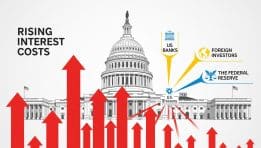U.S. Economic Outlook: Slowing Growth, Cooling Inflation, and a Persistent Fiscal Deficit
The latest U.S. economic forecast paints a complex picture. While inflation is gradually converging toward the Federal Reserve’s target, economic growth is slowing, the housing market is cooling, and the labor market is beginning to lose some of its resilience. At the same time, the federal deficit remains deeply entrenched, and monetary policy is expected to pivot in the coming years. The key question is whether this represents a soft landing or the beginning of prolonged stagnation.
Gradual Slowdown in Growth
The U.S. economy, which expanded by 2.7% in 2024, is projected to slow to just 1.7% in 2025 and 1.6% in 2026. The deceleration is driven largely by weaker business investment—particularly in structures and equipment—alongside modest cuts in government spending. Household consumption continues to provide support, but at a slower pace. Overall, the economy is shifting from robust expansion to a period of stability with limited upside momentum.
Housing Market Loses Steam
The housing sector continues to weaken under the weight of higher borrowing costs. Housing starts, which stood at over 1.5 million units in 2022, are expected to decline to around 1.18 million by 2027. Existing home sales hover near 4 million annually, far below levels seen in the previous decade. Price growth, once robust at 7.5% in 2022, is projected to cool to just 1%–2% annually over the next few years. This slowdown highlights the direct impact of elevated mortgage rates on household demand.
Inflation Converges Toward Target
Perhaps the most encouraging development is on the inflation front. The Consumer Price Index, which reached 8% in 2022, is steadily declining and is expected to stabilize near 2.2%–2.3% by 2026–2027. Core measures (Core CPI and Core PCE) are also converging toward the Fed’s 2% target. This trajectory allows the Federal Reserve greater flexibility to begin gradually lowering rates after a prolonged period of aggressive tightening.
Labor Market Softens
After years of exceptionally tight labor conditions, the job market is showing signs of cooling. The unemployment rate is projected to rise from 3.6% in 2023 to 4.7% by 2027. Wage growth, which reached 5.4% in 2022, is expected to moderate to around 3.2%. While employment remains relatively strong, the slowdown in job creation and softer wage pressures mark a shift toward a more balanced but less dynamic labor market.
Federal Deficit Remains a Drag
Despite slower economic momentum, the U.S. fiscal deficit remains deeply negative, ranging between $1.8 and $2.1 trillion annually. The persistence of large deficits underscores structural challenges in federal spending and raises questions about Washington’s ability to respond effectively to future downturns.
High Rates Today, Easing Ahead
The Federal Reserve’s benchmark rate is expected to hold in the 5.25%–5.5% range throughout 2024, with gradual cuts beginning in 2025. By the end of 2027, rates are projected to decline to around 3.75%. The yield curve is flattening, with 10-year Treasury yields steady near 4%–4.3%. In foreign exchange markets, the U.S. dollar remains relatively stable against the euro but is likely to weaken against the Japanese yen as interest rates decline.
Looking Ahead
The U.S. economic outlook suggests relative stability coupled with a clear trend of deceleration. Inflation is under control, and the Fed appears close to ending its inflation fight. However, rising unemployment, a fragile housing sector, and the persistence of massive federal deficits remain significant challenges. A soft landing is the base case, but external shocks—whether geopolitical or financial—could quickly destabilize the picture.
Comparison, examination, and analysis between investment houses
Leave your details, and an expert from our team will get back to you as soon as possible
* This article, in whole or in part, does not contain any promise of investment returns, nor does it constitute professional advice to make investments in any particular field.
To read more about the full disclaimer, click here- Articles
- •
- 18 Min Read
- •
- ago 5 minutes
 CHINA’S JULY FACTORY OUTPUT, RETAIL SALES GROWTH SLUMP IN BLOW TO ECONOMIC MOMENTUM
CHINA’S JULY FACTORY OUTPUT, RETAIL SALES GROWTH SLUMP IN BLOW TO ECONOMIC MOMENTUM
The Impact of July's Factory Output and Retail Sales Slump on China's Economic Growth In July, China experienced a significant
- ago 5 minutes
- •
- 18 Min Read
The Impact of July's Factory Output and Retail Sales Slump on China's Economic Growth In July, China experienced a significant
- Articles
- •
- 6 Min Read
- •
- ago 2 hours
 A Surge in U.S. Business Applications: Why Entrepreneurship Is Rising Despite Economic Headwinds
A Surge in U.S. Business Applications: Why Entrepreneurship Is Rising Despite Economic Headwinds
A Surge in U.S. Business Applications: Why Entrepreneurship Is Rising Despite Economic Headwinds At a time when economic indicators in
- ago 2 hours
- •
- 6 Min Read
A Surge in U.S. Business Applications: Why Entrepreneurship Is Rising Despite Economic Headwinds At a time when economic indicators in
- Articles
- •
- 6 Min Read
- •
- ago 2 hours
 U.S. Interest Payments Hit Historic Levels: Where Does All the Money Go?
U.S. Interest Payments Hit Historic Levels: Where Does All the Money Go?
U.S. Interest Payments Hit Historic Levels: Where Does All the Money Go? The U.S. government’s interest expenses have surged to
- ago 2 hours
- •
- 6 Min Read
U.S. Interest Payments Hit Historic Levels: Where Does All the Money Go? The U.S. government’s interest expenses have surged to
- Articles
- •
- 18 Min Read
- •
- ago 3 hours
 CHINA’S NEW HOME PRICE DECLINES PERSIST BUT NARROW MODESTLY IN MAJOR CITIES
CHINA’S NEW HOME PRICE DECLINES PERSIST BUT NARROW MODESTLY IN MAJOR CITIES
Analyzing the Factors behind China's New Home Price Declines and Their Impact on Major Cities China is experiencing a notable
- ago 3 hours
- •
- 18 Min Read
Analyzing the Factors behind China's New Home Price Declines and Their Impact on Major Cities China is experiencing a notable












